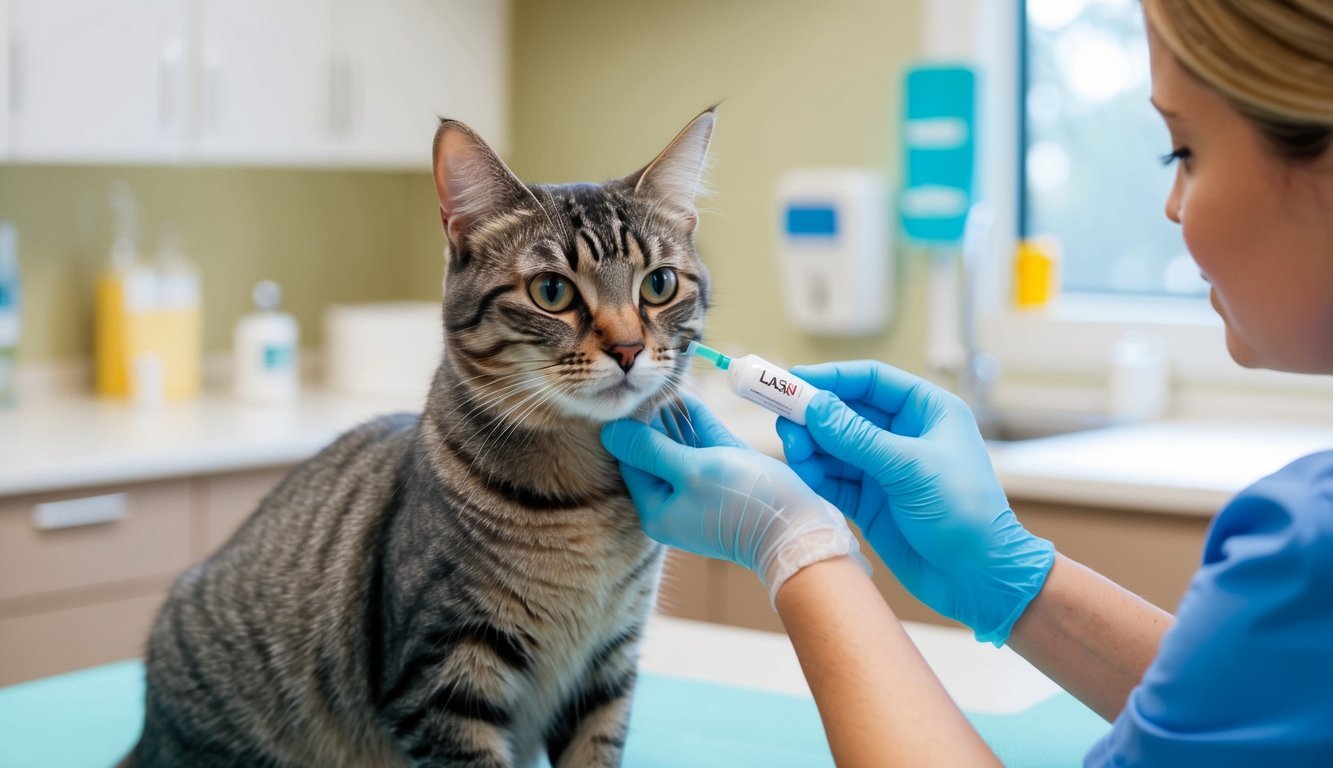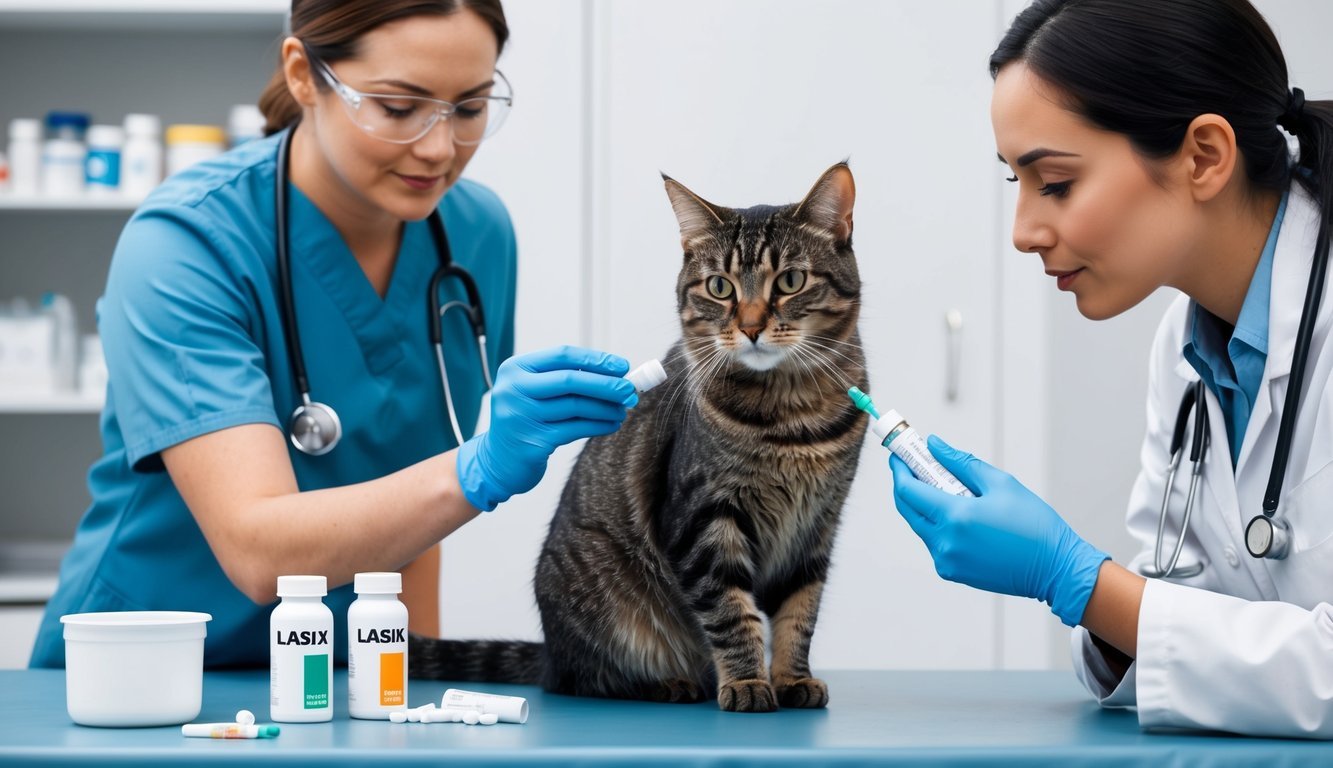Furosemide, commonly known as Lasix, is often prescribed for cats dealing with conditions like congestive heart failure and pulmonary edema. This medication helps your feline friend by promoting urine production, effectively reducing fluid retention and alleviating discomfort.
Administering Lasix can be crucial for managing your cat’s health, but it’s essential to understand how it works and what to expect during treatment.
If your cat has been prescribed Lasix, knowing the proper dosage and potential side effects will help you monitor their health effectively.
Communication with your veterinarian is vital, as they can guide you in adjusting dosages and addressing any concerns that may arise.
As a pet owner, being informed about your cat’s treatment plan can lead to better outcomes and a happier, healthier life for your beloved companion.
Key Takeaways
- Lasix is effective for managing fluid retention in cats.
- Monitoring your cat is crucial while on this medication.
- Consult your vet for the best treatment approach.
Understanding Lasix and Its Uses

Lasix, the brand name for furosemide, is a powerful diuretic frequently prescribed for cats.
Its primary role is to help manage excess fluid buildup due to various medical conditions, thus improving your cat’s quality of life.
What Is Lasix?
Lasix is a diuretic medication that promotes urine production.
It works by inhibiting the reabsorption of sodium and chloride in the kidneys.
As a result, your cat will excrete more water and salt, helping to reduce fluid accumulation in the body.
This medication is crucial for treating specific health issues in felines.
It is typically administered either orally or via injection, depending on the severity of the condition being treated.
Role of Lasix as a Diuretic
As a diuretic, Lasix plays a vital role in managing fluid retention.
It helps prevent conditions such as edema, where excess fluid accumulates in tissues.
- Fluid Build-up: This can occur in the lungs (pulmonary edema) or in other tissues.
- Heart Disease Relief: In cases of heart disease or hypertrophic cardiomyopathy, Lasix alleviates strain on the heart by reducing fluid overload.
Understanding how Lasix works allows you to appreciate its importance in your cat’s treatment plan.
Conditions Treated by Lasix in Cats
Lasix is primarily used to manage several conditions, including:
- Congestive Heart Failure (CHF): This common ailment in older cats leads to fluid accumulation in the lungs and abdomen.
- Pulmonary Edema: Accumulation of fluid in the lungs that can make it hard for your cat to breathe.
By addressing these conditions, Lasix can help improve your cat’s overall comfort and health.
It is important to follow your veterinarian’s instructions on dosage and administration to achieve the best therapeutic effect.
Vital Considerations Before Using Lasix

Before administering Lasix (furosemide) to your cat, it’s crucial to review their medical history and understand potential contraindications.
Being informed can help ensure your cat receives the safest and most effective treatment.
Medical History Review
You should have a thorough review of your cat’s medical history done by your veterinarian before prescribing Lasix.
Conditions like kidney disease can influence how well your cat responds to this medication.
Kidney function is essential as Lasix is a diuretic, which means it can strain the kidneys.
Regular blood tests may be necessary to monitor electrolyte levels, particularly potassium, which can fluctuate with Lasix use.
You want to keep an eye on potential electrolyte imbalances, as these can lead to serious complications.
Always inform the vet about any previous health issues or current medications your cat is taking.
Potential Contraindications
Certain factors might make Lasix unsuitable for your cat.
Serious drug interactions could occur if your cat is on medications like NSAIDs or other diuretics.
These interactions can diminish the effectiveness of either drug or increase the risk of side effects.
Cats with pre-existing heart issues or dehydration should be approached with caution when considering Lasix.
Dehydrated cats may develop further complications, like acute kidney injury, if given this medication.
Your veterinarian will help assess these risks and guide you on the safest course of action.
Administering Lasix to Cats

Administering Lasix, or furosemide, to your cat requires careful attention to dosage and adjustments based on their specific health needs.
Understanding these aspects can help you manage your pet’s condition more effectively.
Determining the Correct Dosage
When starting Lasix for your cat, it’s crucial to consult with your veterinarian to determine the appropriate dosage.
Typically, dosages range from 1 to 4 mg per kilogram of body weight, depending on the condition being treated, such as congestive heart failure.
Your vet will consider factors like your cat’s overall health, age, and response to the medication.
It’s common for furosemide to be administered either once or twice daily.
Remember, following your veterinarian’s prescription is essential.
Here’s a quick reference for dosage:
| Cat Weight (kg) | Dosage (mg) |
|---|---|
| 2 | 2-8 |
| 4 | 4-16 |
| 5 | 5-20 |
The Importance of Dosage Adjustment
Monitoring your cat’s response to Lasix is vital.
If your cat shows signs of side effects, your veterinarian may need to adjust the dosage.
This can include symptoms like increased thirst, urination, or even gastrointestinal issues.
Dosage adjustments are often necessary due to factors such as changes in your cat’s weight or health status.
Regular check-ups allow your vet to modify the dosage as needed.
Key Points for Dosage Adjustment:
- Observe for side effects.
- Communicate changes in health or behavior to your vet.
- Regular veterinary check-ups can help tailor the treatment.
Each cat’s response to medication can vary, making it imperative to follow your veterinarian’s guidance closely.
Recognizing and Managing Side Effects
When administering Lasix (furosemide) to your cat, it’s crucial to be aware of potential side effects.
Understanding these effects can help you manage your cat’s health more effectively.
Common Side Effects
Furosemide can lead to several side effects that you’ll want to monitor closely.
The most common include:
- Increased Thirst: Your cat may drink more water than usual.
- Increased Urination: Expect more frequent trips to the litter box.
- Nausea: Some cats may show signs of nausea through behavior changes.
- Vomiting and Diarrhea: These could indicate digestive disturbances.
Keep an eye on your cat’s overall behavior.
If you notice persistent vomiting or diarrhea, consult your veterinarian promptly, as these symptoms may require adjusting the medication.
Monitoring for Dehydration and Electrolyte Balance
Dehydration is a significant risk when your cat is on furosemide.
Symptoms can include dry gums, lethargy, and decreased skin elasticity.
To keep your cat well-hydrated, ensure that fresh water is always available.
Electrolyte imbalances can occur due to increased urination.
Monitor your cat for signs like weakness or unusual behavior.
Regular veterinary check-ups can include electrolyte level tests, which are essential for cats on Lasix.
By actively observing these aspects, you can help maintain your cat’s health and respond effectively if any side effects arise.
Combining Lasix with Other Medications

When managing a cat’s health, it’s essential to consider how Lasix (furosemide) interacts with other medications.
This section covers the safe use of Lasix alongside different diuretics and provides insight into potential drug interactions.
Using Lasix in Conjunction with Other Diuretics
Lasix is a loop diuretic, which means it primarily promotes urine production by inhibiting sodium reabsorption in the kidneys.
If your vet prescribes other diuretics, such as potassium-sparing diuretics, it’s important to monitor your cat carefully.
Combining these can enhance diuresis but also increase the risk of electrolyte imbalances.
- Loop Diuretics: Such as torsemide, might be used simultaneously for severe cases.
- Potassium-Sparing Diuretics: Help to retain potassium, counteracting some side effects of Lasix.
Always work with your vet to determine the right combination and dosage to avoid complications.
Understanding Drug Interactions
Lasix can interact with various medications, affecting its efficacy and safety.
Knowing these interactions helps you manage your cat’s treatment effectively.
-
NSAIDs: Nonsteroidal anti-inflammatory drugs may reduce the effects of Lasix.
-
Antibiotics: Some antibiotics can lead to increased toxicity when used with Lasix.
-
Other Diuretics: As mentioned, caution is required when combining with other diuretics.
Make sure to inform your vet about all medications your cat takes, including supplements.
Regular monitoring of electrolyte levels may also be beneficial to catch any imbalances early on.
Monitoring Cat Health and Lasix Efficacy
When your cat is prescribed Lasix (furosemide), keeping a close eye on their health is crucial.
Regular monitoring can help ensure that the medication is effective while maintaining your cat’s comfort and quality of life.
Assessing Kidney Function Regularly
Kidney function is vital when your cat is on Lasix.
Furosemide can affect renal health, so it’s important to have regular blood tests.
These tests check the levels of waste products like creatinine and blood urea nitrogen (BUN).
- Frequency: Aim for evaluations every 2-4 weeks after starting treatment, and adjust based on your veterinarian’s advice.
- Signs of Concern: Watch for increased thirst or urination, which may indicate kidney strain.
Consult your veterinarian to interpret results.
They can guide dosage adjustments if necessary, helping to maintain a balance between efficacy and potential side effects.
Watching for Changes in Condition
Keep an eye on your cat’s behavior and physical condition.
Changes can indicate how well Lasix is working and whether your cat is experiencing side effects.
- Behavioral Changes: Notice any lethargy, reduced appetite, or changes in activity level. These could signal discomfort or complications.
- Physical Signs: Monitor for weight loss or swelling, which may suggest fluid retention or other issues.
It’s essential to communicate any concerns to your veterinarian promptly.
They can make necessary adjustments to ensure your cat remains comfortable and enjoys a good quality of life while on Lasix.
Supporting Your Cat Beyond Medication

Managing your cat’s health, especially with conditions like congestive heart failure, involves more than just medication.
You can enhance your pet’s quality of life through careful diet choices and a supportive environment.
Here’s how you can help your cat thrive.
Diet and Lifestyle Adjustments
The right diet plays a crucial role in managing your cat’s condition.
Focus on providing high-quality, low-sodium foods.
This helps reduce fluid retention, which can lead to swelling or ascites.
Consider incorporating omega-3 fatty acids into their diet.
These are beneficial for heart health and can be found in fish oil supplements.
Be sure to consult your veterinarian for appropriate dosages.
Monitor your cat’s hydration levels.
While you want to ensure they drink enough, too much fluid can exacerbate symptoms.
Provide fresh water daily and adjust their intake based on the recommendations from your vet.
Also, keep their weight in check.
Maintaining a healthy weight can alleviate additional strain on the heart.
Weigh your cat regularly and adjust their food portions as necessary.
Creating a Comfort-Oriented Environment
Creating a comforting space for your cat is essential, especially if they experience symptoms like pleural effusion or general discomfort.
Choose a quiet area with soft bedding.
This way, your cat can rest peacefully.
Avoid loud noises and sudden disruptions; these can increase stress levels.
High-stress environments can worsen your cat’s overall quality of life, making it harder for them to cope with their condition.
Ensure your cat has access to their favorite perch or resting spot.
Elevated areas can help them breathe more comfortably if they have lung-related issues from their condition.
Lastly, consider low-impact playtime.
Engaging them gently can improve their mood without exhausting them.
Simple activities can stimulate their mind and support their emotional well-being, enhancing their overall comfort.
Frequently Asked Questions
You probably have some questions about Lasix for your cat.
This section addresses common queries related to side effects, dosing, costs, and its effectiveness for conditions like congestive heart failure.
What are the common side effects of Lasix in cats?
Some cats may experience increased thirst and urination after taking Lasix.
Other potential side effects include electrolyte imbalances and changes in appetite.
It’s important to monitor your cat for any unusual behavior or symptoms while on this medication.
How should Lasix be dosed for cats?
Typically, the dosage of Lasix for cats ranges from 1 to 4 mg per kilogram of body weight.
Your veterinarian will determine the specific dose based on your cat’s health needs.
Dosing is usually done once or twice daily.
What is the cost range for Lasix treatment in felines?
The cost of Lasix can vary depending on the pharmacy and dosage.
Generally, you might expect to pay between $15 to $30 for a month’s supply.
It’s best to consult your vet or local pharmacy for accurate pricing.
Can Lasix help cats with congestive heart failure?
Yes, Lasix is commonly prescribed to manage congestive heart failure in cats.
It helps reduce fluid buildup by acting as a diuretic, which can enhance your cat’s comfort and overall health.
How quickly does furosemide start working in felines?
Furosemide generally starts working within one to two hours after administration.
You might notice a difference in your cat’s urination patterns shortly after giving the medication.
Does administering Lasix to cats increase their thirst?
Yes, cats often show increased thirst while on Lasix.
The medication causes more frequent urination, so your cat may feel the need to drink more water to stay hydrated.

